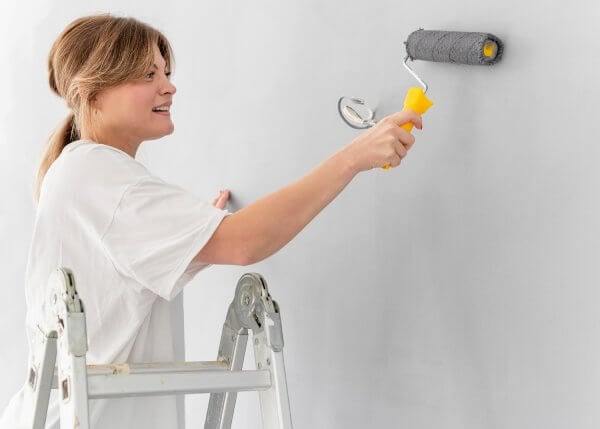
Are you planning to paint your walls and wondering how to combine wall colours so the interior looks cohesive and aesthetically pleasing? Choosing the right colours is a key element of space arrangement, which affects not only the look of the room but also the well-being of the household members. That’s why today we decided to tell you more about what appropriate colour matching means to achieve a harmonious effect. We will talk a bit about the colour wheel, remind you of the rules of combining colours, and showcase inspiring combinations for every occasion.
What will you learn from this article?
- Why it’s worth having at least a basic knowledge of colour combinations.
- Which colours work best on the walls of specific rooms.
- What mistakes are most often made when it comes to painting walls.
How to combine wall colours?
Choosing the right colours for walls is a process worth planning thoughtfully. Wall colours not only define the character of the room but also allow you to change the proportions of the interior, the prevailing atmosphere, and its overall perception. The basic tool that facilitates this process is the colour wheel, the knowledge of which can make painting a room significantly easier, regardless of whether it needs painting on one wall or all of them.
The colour wheel — how to achieve the right colour combinations?
The colour wheel is a graphic representation of colours that helps in their proper arrangement. It is divided into three main groups:
- primary colours — yellow, blue, red,
- secondary colours — obtained by combining primary colours, e.g., orange, green, purple.
- complementary colours — located on opposite sides of the colour wheel, e.g., yellow and purple, blue and orange.
Knowing the colour palette well allows you to combine colours thoughtfully and aesthetically.

Rules for combining colours
When planning colour combinations on walls, it’s worth considering a few tried-and-true principles:
- analogous colours — choosing colours adjacent on the colour wheel, e.g., green and blues. They create a cohesive, gentle effect,
- complementary colours — combining colours from opposite sides of the colour wheel, e.g., orange and blue. They add energy and contrast to the interior,
- light and dark tones — combining light colours with intense shades (e.g., white with emerald green) to create an interesting contrast.
Combining wall colours in practice
Every interior has its purpose, and the right wall colours can emphasize its character:
- Living room — warm colours like beige, ochre, or light orange work great, adding coziness to the interior. In large living rooms, you can boldly experiment with contrasts, such as pairing white with navy blue to emphasize the elegance of the room.
- Bedroom — opt for subtle shades like pastel blues, pinks, or greens, which promote relaxation. In recent years, dark-coloured bedrooms, like graphite or bottle green, are also in fashion, creating an intimate and peaceful atmosphere.
- Kitchen — intense colours, such as red, which stimulates appetite, or greens, which add freshness, are appropriate. In modern kitchens, combining white with wood and black accents works well.
- Bathroom — although white is the most common choice for painting walls in this room, you might also consider subtle shades of blue, grey, or sandy beige. In modern bathrooms, dark colours like graphite or anthracite, combined with large mirrors, create a luxurious effect.
- Small rooms — light colours like white, beige, or pastel shades visually enlarge each of these spaces.
How to combine colours in small interiors?
In small spaces, it’s crucial to arrange colours so the space appears larger. Here are a few tips:
- light shades — walls in white, grey, or delicate blue.
- darker accents — it’s worth painting one wall in an intense colour, such as navy blue or green, to add depth to the room.
- monochromatic combinations — combining different tones of one colour, e.g., light beige with dark brown.
- mirrors and accessories — proper placement of mirrors and choosing decorations in light colours, such as gold or silver, can further visually enlarge the space.

Trendy wall colour combinations
Current interior trends emphasize the importance of contrasts and natural inspirations. Here are a few examples:
- black and white combination — timeless classic, ideal for modern interiors,
- earth tones — browns, beiges, and greens create warm, natural arrangements,
- pastel shades — pink, blue, and mint are great for bedrooms and children’s rooms,
- bold colours — a combination of yellow with purple or navy with orange introduces energy and modern style,
- industrial accents — raw brick red combined with graphite and concrete shades is a hit in recent years.
What to avoid when combining wall colours?
Combining colours is both an art and a challenge. To avoid chaos, it’s worth remembering a few principles:
- Don’t overdo the number of colours — we advise limiting to 2-3 colours in one room,
- Avoid using very dark colours in small spaces — they can make the interior feel claustrophobic,
- Pay attention to lighting — sunlight can change how colours are perceived. In rooms with little natural light, it’s better to opt for light colours to avoid a cramped feeling,
- Avoid intense contrasts without preparation — if unsure about the effect, it’s good to try out paint samples and test colours before painting.
Why might knowledge of the colour wheel be important in the wall painting process?
Painting walls is an excellent way to give interiors a new character. By appropriately combining colours, you can visually enlarge the space, improve the proportions of the interior, and create arrangements that encourage relaxation.
When planning to paint, always remember the basic principles from the colour wheel. Matching the palette to the function of the room and considering the character of the interior are of great importance. Ultimately, it’s always worth backing up your colour choices with tests and matching the colours to the lighting in a given room. This will help avoid common mistakes made by both amateurs and sometimes professionals.


















